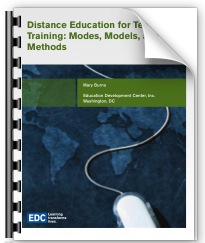Distance Education Should Be a Viable Solution to Create Quality Teaching
The greatest single predictor of student achievement is access to a high-quality teacher. The difference between having a good teacher and a bad teacher can exceed one grade level in annual achievement growth—a massive effect when one considers that in so many parts of the globe, children receive only a primary school education. Access to quality teaching (I’m using teaching and teacher synonymously) is more even beneficial for poor kids than wealthy ones and these effects are cumulative over time.
We know what constitutes high-quality teaching—a teacher’s deep knowledge of content, instructional knowledge, the ability to utilize multiple and appropriate assessment strategies, knowledge of how students learn, and a sense of efficacy (belief that all students can learn).
We also know the qualities of high-quality professional development (some of which are instruction and learning experiences for teachers that are content-focused and centered on improving student learning outcomes; and that are long-term, ongoing, sequential, cumulative and offer ongoing support).
We don’t understand as much about technology as we do about teaching and professional development. Still, we know that some modes of ICTs (e.g., Interactive Radio Instruction) have richer bodies of research than others (online or mobile learning). Because distance learning has a long history, we have some understanding of the types of distance technologies that have or have not proved to be effective vehicles for addressing particular knowledge and skills (either because they have failed to attain intended results or because they show no significant differences). For instance, television and video are effective media for helping teachers understand processes and procedures; Interactive Audio Instruction offers highly structured in-class support that can help teachers acquire “basic” instructional skills, etc.
Taken together, the above three items—understandings of good teaching, good professional development and appropriate technologies— should mean that distance education is a viable solution to create the types of quality teaching we want. Unfortunately, many models of distance education in poorer countries do little, in their current form, to help “develop” the kind of high quality teachers students need. This has less to do with technology. Rather it is the cumulative result of perceptions, understandings of change and an overly narrow focus on scale:
Perception. First, for too many distance learning is online learning and many places have neither the technical readiness (Internet penetration, access to broadband, local language digital content) or the human readiness necessary to be a successful online leaner (high degrees of literacy—reading, writing, technical and the qualities of self-directedness, time management, the ability to manage information, etc.). In spite of this, many decision makers want online learning—even when the country is in no way ready for it! Other distance technologies with far more proven track records (like IRI) are seen as less “sexy” than online learning. Bandwidth drives content choices, so distance courses in low-bandwidth settings have more asynchronous communication and text-based content and are focused more on propositional knowledge. With more robust connections that support video examples and synchronous, face-time instruction, teacher-learners could do good instruction and discuss/collaborate around good instruction with online colleagues versus simply learning about good instruction.
Understanding How Change Occurs. Second, in-service distance-based professional development programs aim to “retro-fit” teachers who have matriculated through what is often a weak pre-service system. Yet the qualities of good teaching mentioned above are incredibly complex and take years to develop and cultivate. The problem is many in-service distance programs often attempt to turn a low-quality teacher into a high-quality one in a very compressed amount of time—months versus years—and attempt to do so without providing teachers with support either in terms of human and digital supports or through a distance program that offers structure and scaffolding. (Support is absolutely essential to any “successful” implementation, no matter the field.)
Overly Narrow Focus on Scale. Finally, the focus on scale (quantity) really is the enemy of the good (in this case, quality). More often than not for decision makers, “scale” means numbers—replication, quantification, expansion— and is totally input focused (How many teachers are trained? How much will this cost?), and the type of technology to be used (“Online learning has the potential for scale”) versus the set of practices to be delivered or cultivated. Often this results in design of lower-quality courses than high-quality ones (easier to scale), and a focus on simple or simplistic interventions for teachers (easier to scale) versus focusing on the complex set of characteristics that actually define good teaching.
So, what can designers of distance learning do to address these issues and improve distance education for teachers?
- Focus on appropriate technology, not sexy ones. What do teachers need to know and be able to do and what mode of distance technology can best “bundle” the instruction they need help them achieve this? (The first half of the featured distance education guide focuses on these technologies.)
- Understand that change is a long process and design all distance program elements to support teachers in the change process. (Part of the second half of the featured distance education guide focuses on designing for support.)
- Broaden understandings of scale. Scale is about depth as well as reach. It is about the spread of a set of proven pedagogical practices between and within classrooms, schools, and districts. It is about shifts in ownership from an externally understood and supported theory to internalized classroom practice and sustainability. Scale is not about technology—about hardware or software, but rather about “wetware” (Judi Harris’s term)—learning that helps teachers access, use, understand content and apply effective instruction in ways that have demonstrable impact on student achievement.
To help designers achieve these goals, Education Development Center has developed a free distance education guide, Distance Education for Teacher Training: Modes, Models and Methods highlighting:
- Modes of distance education—types of distance-based delivery systems and their strengths and weaknesses from print to digital gaming to online learning to mobile technologies
- Models of distance education for teacher training programs—actual examples of various programs from each continent
- Methods or best practices necessary to develop a high-quality distance education programs in over 100 nations and territories.
Unlike most distance-education books, this guide focuses less on policy and funding, and almost exclusively on building high-quality teaching and learning within a distance-based system. With over 200 web references to existing programs and technology tools; an annotated reference section of distance-based resources; and an extensive glossary of terms and bibliography, this guide is a valuable resource for those interested in not just distance education but technology and professional development.
I hope this will be a valuable resource for education policymakers and planners.
Mary Burns is a senior technology specialist at Education Development Center, an international non-profit based outside of Boston, MA. A former teacher and school-based coach, Ms. Burns has designed, delivered and evaluated face-to-face and web-based professional development for teachers across the globe since 1997. She designed and evaluated Indonesia’s national distance education pilot and Mali’s first-ever online learning program for teacher training faculty and is helping to develop Lebanon’s national ICT in education strategy. She has published books, monographs, journal articles and book chapters on using technology to support teacher learning and is the author of Distance Education for Teacher Training: Modes, Models and Methods.



I joined the conversation late, but your comments resonate so much with my work… a key word we deal with so often is scale and distance/online solutions seem an attractive avenues for professional development. We just have to remember that change requires time, and online solutions are not a miracle; support is not only necessary, but the most important component in professional development; and like you said, scale is not just about reach, it is also about depth.